"Upon one occasion, while engaged upon a seven-foot mirror, he did not remove his hands from it for 16 hours together." -from Caroline Herschel's obituary
Welcome to another Messier Monday here on Starts With A Bang! Each Monday, we highlight a different one of the 110 deep-sky objects that Messier catalogued so that comet-hunters wouldn't confuse these permanent fixtures with transient comets. But each object has a unique, remarkable story in its own right.
Out of the 110 objects, a full forty of them are galaxies external to our own, with twenty-seven of them being spiral galaxies. However, despite Messier's Catalogue being composed in the 18th Century, the spiral nature of their structure was completely unobservable until 1845, when the first (as it was then-called) "spiral nebula" was discovered: Messier 51. Here's how to find it.
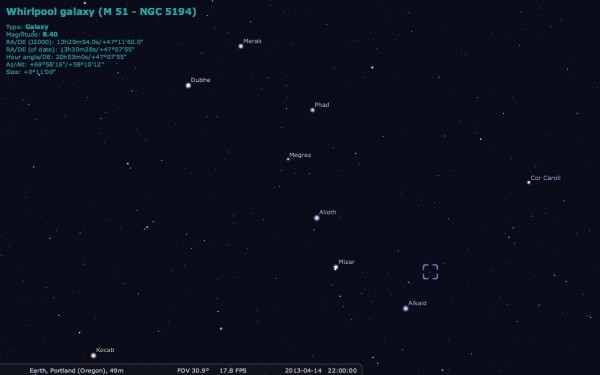 Image credit: me, using the free software Stellarium, available at http://stellarium.org/.
Image credit: me, using the free software Stellarium, available at http://stellarium.org/.
Perhaps the most recognizable collection of seven stars in the entire night sky, the asterism of the Big Dipper is easily found by even the most novice of skywatchers. And the very first deep-sky object to be identified as a spiral -- although it very likely won't appear as a spiral to your eyes -- can be found by just a little star-hopping from the star at the tip of the handle, Alkaid. From the end of the Dipper, just head about 2.5 degrees towards Cor Caroli, or locate it relative to the surrounding stars (in a telescope at low-power or binoculars) as shown in the image below.
Now, this is one of the most famous spiral galaxies of all-time, so much so that it has a name: the Whirlpool Galaxy. And while images of it are iconic -- even among amateurs -- you likely won't be able to see the fabulous spiral structure if you're looking with your eye through an eyepiece.
Until you look through a telescope yourself, you simply don't realize just how faint, diffuse and fuzzy these galaxies actually appear. They're more like hazy, light, monochrome clouds that never move -- to the naked eye, at least -- than they are like the brilliant spirals you see in photographs. This might strike you as odd, though. That's because, routinely, astrophotographers post stunners like this. (As always, on this and every image, click for the full-size version.)
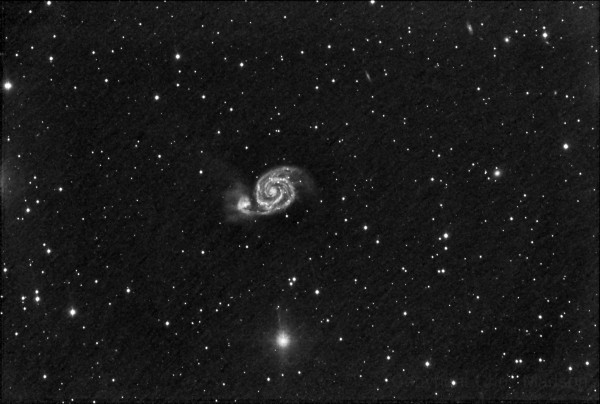 Image credit: Christopher Madson, at http://www.astrobin.com/38809/.
Image credit: Christopher Madson, at http://www.astrobin.com/38809/.
Astrophotography has the benefit of much longer exposures to bring out the detail your eyes aren't equipped to see, and that's simply because your eyes simply can't gather enough light, quickly enough, to see more structure than that! Messier's original description contained the following:
Very faint nebula, without stars, near the eye of the Northern Greyhound, below the star Eta of 2nd magnitude of the tail of Ursa Major... One cannot see this nebula without difficulties with an ordinary telescope of 3.5 foot: Near it is a star of 8th magnitude... It is double, each has a bright center, which are separated 4'35". The two "atmospheres" touch each other, the one is even fainter than the other. Reobserved several times.
It wasn't until a telescope whose mirror was a full six feet in diameter became operational that a naked-eye observer, for the first time, was able to see the spiral structure.
 Image credit: Canadian Space Agency, from http://www.asc-csa.gc.ca/.
Image credit: Canadian Space Agency, from http://www.asc-csa.gc.ca/.
This telescope was the famed Leviathan of Parsonstown, which would have more light-gathering power than any telescope in the world until the dawn of the 20th Century! Lord Rosse, who invented many of the new techniques required for constructing such a behemoth, trained his eye on a great many objects both in and beyond the Messier Catalogue. But when he came to the 51st object, he was able to produce something that no one else had.
This now-famous drawing was the very first sketch of a deep-sky object that revealed its spiral structure, and it took a telescope 72-inches (1.8 meters) in diameter to do it! Over the subsequent years, dozens more were discovered to be spirals, but Messier 51 -- now known as the Whirlpool Galaxy -- was the first!
But some of the images we can obtain of it now are truly spectacular. Let's talk you through what's going on here.
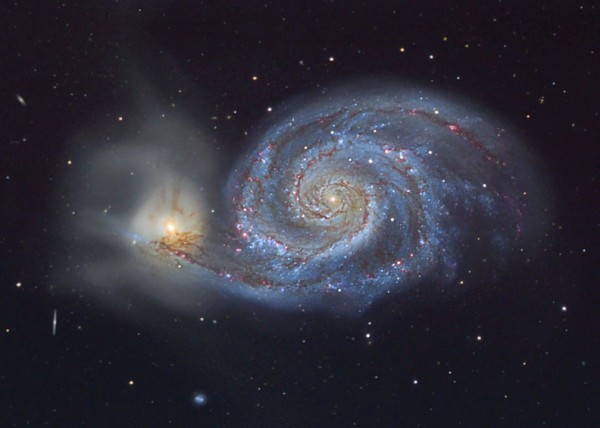 Image credit: Tony and Daphne Hallas of http://www.astrophoto.com/.
Image credit: Tony and Daphne Hallas of http://www.astrophoto.com/.
As you can see, there are two galaxies here! There's what appears to be a smaller, severely disrupted elliptical galaxy at one edge of the larger, grand design spiral galaxy that dominates the system.
The spiral arms are clearly distorted by the gravitational presence of the smaller companion, and the hot pink color is a telltale sign of new star formation. Additionally, the bluish color that paves the spiral arms is evidence of young, hot stars (whose color is naturally blue) that have recently formed.
The fact that the larger, spiral-shaped galaxy is only slightly distorted very likely tells us that the elliptical galaxy is much lower in mass, while the intense evidence of star formation in the spiral and severe distortions in the smaller companion show that these two galaxies are in the middle stages of a merger. They've very likely already made their first pass through one another at some point about half-a-billion years ago, are decidedly gravitationally bound, and are coming back for another interaction.
The entire merger process will likely take another two-to-three passes to complete, a cosmic ballet that will last hundreds of millions of years, at minimum.
Perhaps unbelievably, Messier 51 is maybe 25% smaller than our own Milky Way in extent, at just about 75,000 light-years in diameter, which would make it only about 160 billion solar masses all told, which may mean it's less than half the mass of the Milky Way all told.
But with a galaxy like this -- this close, this face-on, and this interesting -- you don't pass up the chance to view it in as many different wavelengths as possible.
The Ultraviolet view, courtesy of GALEX, shows off the hot, blue stars in the face-on spiral, while the companion galaxy is barely visible as a faint, red glow. This tells us that practically no new stars have formed in the companion galaxy -- which was either dust-poor to begin with or has been stripped -- but that the new stars have formed in the main spiral, and have formed in the same spiral pattern that we see in the visible!
Even farther into the high-energy spectrum the X-ray data -- courtesy of Chandra -- shows what are very likely two supermassive black holes at the center of each galaxy, spitting out intense X-rays, while lower-mass black holes are visible as point sources throughout! There are also more diffuse regions, which normally show off gas that's heated up intensely, so hot that it will emit soft X-rays.
On the other, cooler end of the electromagnetic spectrum, there's infrared light, which comes to us courtesy of the Spitzer Space Telescope. In the image above, the blue color represents cool, older stars, while the red represents warm dust. "Warm" is a relative word; the dust we see is very, very hot compared to intergalactic space, but is cool compared to say, a star. Much of the gas you're seeing here, however, is just slightly colder -- on a cosmic scale -- than room temperature, which means the red light shows you where the next generation of stars will be forming in this grand spiral.
And of course, in the visible light, there's a shot from the incomparable Hubble Space Telescope.
There is, as is often the case, a behemoth version of the Hubble image, which is actually not the first time that Hubble imaged this. Using an earlier camera pointed directly at the core of the spiral galaxy, Hubble was able to find a pair of dust lanes at the center of this galaxy back in 1992!
If we put these different wavelength images together -- X-ray, UV, visible, and IR -- we can see just what these different views shown all at once tell us! Below, Chandra's X-rays are depicted in purple, GALEX's UV are shown in blue, the Hubble picture of the optical lights up in green, while Spitzer's IR data is appears in red. The complete picture is staggering.
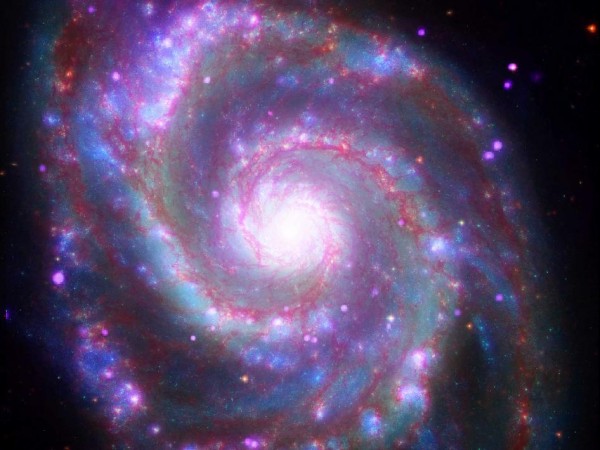 Image credit: X-ray: NASA/CXC/Wesleyan Univ./R. Kilgard; UV: NASA/JPL-Caltech; Optical: NASA/ESA/S. Beckwith & The Hubble Heritage Team (STScI/AURA); IR: NASA/JPL-Caltech/Univ. of Az/R. Kennicutt.
Image credit: X-ray: NASA/CXC/Wesleyan Univ./R. Kilgard; UV: NASA/JPL-Caltech; Optical: NASA/ESA/S. Beckwith & The Hubble Heritage Team (STScI/AURA); IR: NASA/JPL-Caltech/Univ. of Az/R. Kennicutt.
And finally, for those of you who need a glimpse of the ultra-hi-res Hubble picture, here's just a tiny strip -- shown vertically, at full resolution -- of the interacting pair that makes up Messier 51! (And give it a sec; it's got to load!)
That's the amazing story of the first Spiral Galaxy ever discovered, Messier 51, the Whirlpool Galaxy!
Including today, we’ve taken a look at the following Messier objects:
- M1, The Crab Nebula: October 22, 2012
- M8, The Lagoon Nebula: November 5, 2012
- M13, The Great Globular Cluster in Hercules: December 31, 2012
- M15, An Ancient Globular Cluster: November 12, 2012
- M25, A Dusty Open Cluster for Everyone: April 8, 2013
- M30, A Straggling Globular Cluster: November 26, 2012
- M33, The Triangulum Galaxy: February 25, 2013
- M37, A Rich Open Star Cluster: December 3, 2012
- M40, Messier’s Greatest Mistake: April 1, 2013
- M41, The Dog Star’s Secret Neighbor: January 7, 2013
- M44, The Beehive Cluster / Praesepe: December 24, 2012
- M45, The Pleiades: October 29, 2012
- M48, A Lost-and-Found Star Cluster: February 11, 2013
- M51, The Whirlpool Galaxy: April 15th, 2013
- M52, A Star Cluster on the Bubble: March 4, 2013
- M53, The Most Northern Galactic Globular: February 18, 2013
- M60, The Gateway Galaxy to Virgo: February 4, 2013
- M65, The First Messier Supernova of 2013: March 25, 2013
- M67, Messier’s Oldest Open Cluster: January 14, 2013
- M72, A Diffuse, Distant Globular at the End-of-the-Marathon: March 18, 2013
- M74, The Phantom Galaxy at the Beginning-of-the-Marathon: March 11, 2013
- M78, A Reflection Nebula: December 10, 2012
- M81, Bode’s Galaxy: November 19, 2012
- M83, The Southern Pinwheel Galaxy, January 21, 2013
- M97, The Owl Nebula, January 28, 2013
- M102, A Great Galactic Controversy: December 17, 2012
Come back next week, where we'll take a tour of another one of Messier's 110 deep-sky objects, only here on Starts With A Bang's Messier Monday!
- Log in to post comments

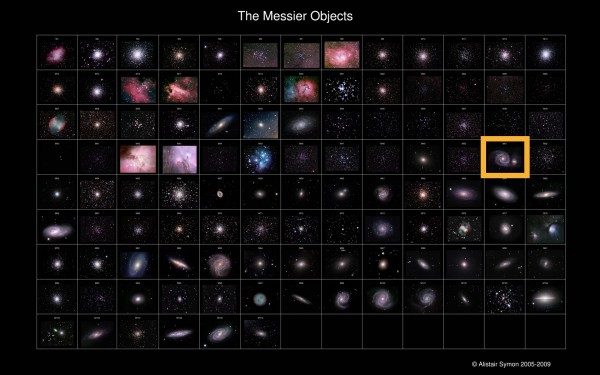
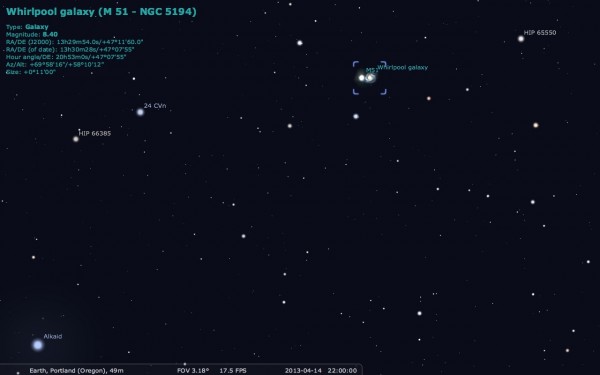
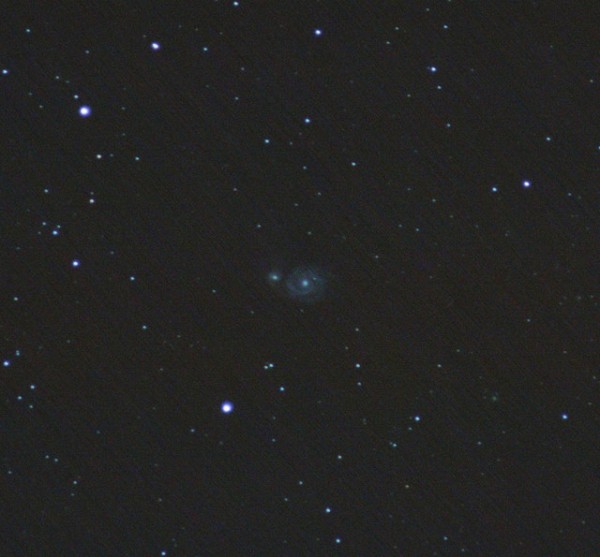

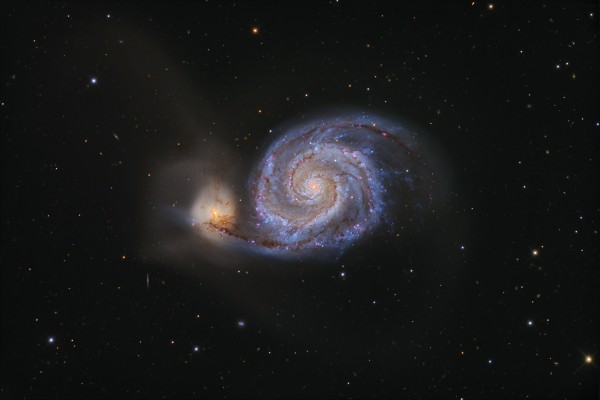
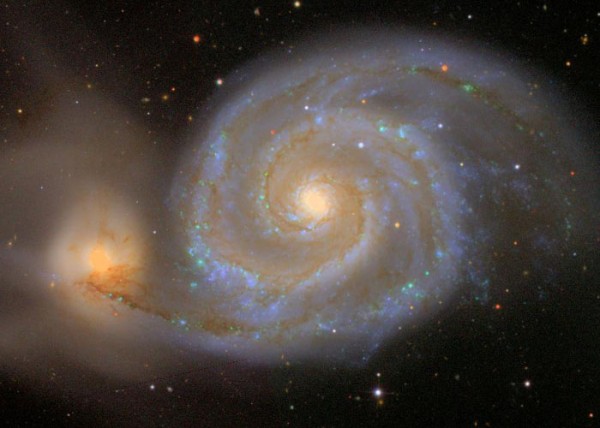
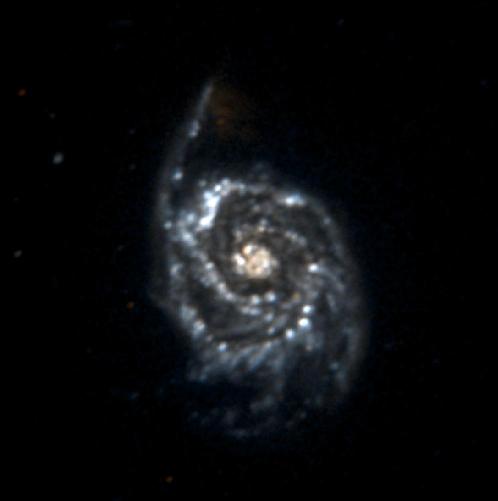
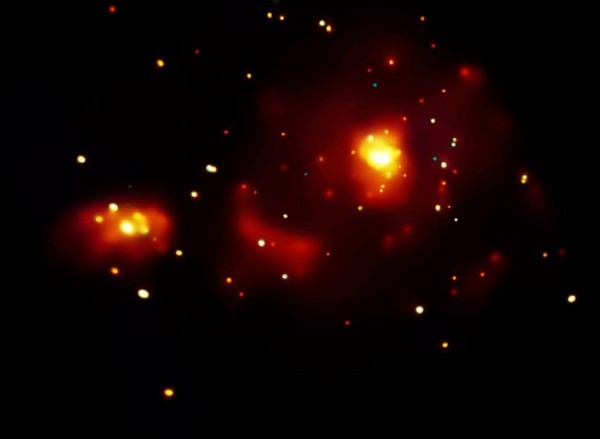
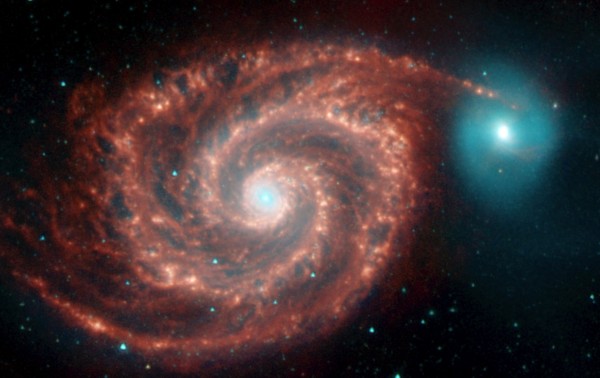
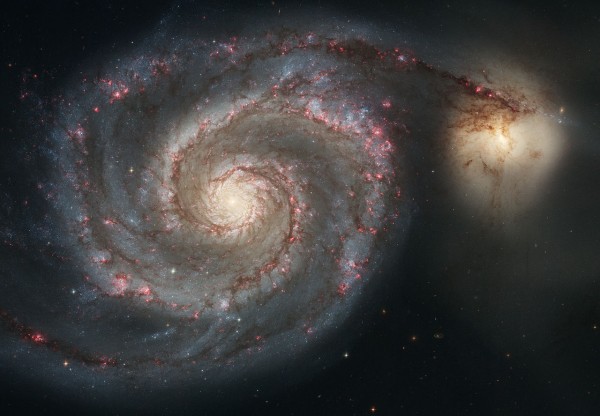
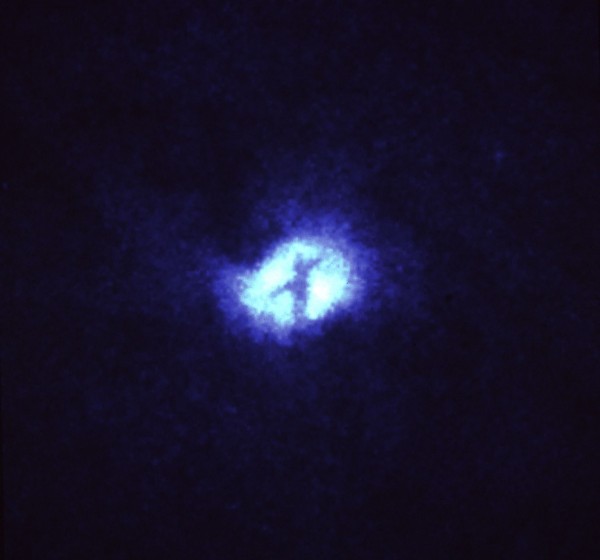

I am loving these Messier galaxy articles! Thank you for all your work! I do have one question about this one, though.
"shows what are very likely two supermassive black holes at the center of each galaxy" - do you mean each galaxy has two black holes at its center? I only ask because (I'm a lay person totally) it seems to me the shapes of the galaxies might appear differently than they do, if there were two at each one's heart.
Terry,
I meant: "two supermassive black holes, one at the center of each galaxy". Sorry about that!
There are galaxies with two supermassive black holes at the center, and they are notable, interesting and amazing in their own right, like here: http://scienceblogs.com/startswithabang/2011/04/05/fun-with-colliding-g…
But I should be more precise with my language. Thanks!
Wow! The cosmos never ceases to amaze me! I really need to get myself a telescope and camera and learn how to photograph galaxies. I would love to some day show this stuff to my not-yet-two-year-old daughter, when she is older.
Get a cheap achromat f8-12/F700-900 on an equatorial mount with the scope having a 1/4" whitworth thread to put your camera on and you'll be sorted to start with minimal investment.
That would cost you ~$300 and last pretty much maintenance free for 10 years and will be decent enough for 50 (the high-transmission coatings will probably start going before 10 years, but they aren't essential).
I have got the hubble image as a 1m wide printout on the wall of my bedroom.. when I get to sleep, i can dream of the stars looking at it :)
Too bad this is not part of the Local Group.
Ethan, is there any possibility of using halo stars as gravitational lenses to get a close-up on the "central engine"/black hole at the whirlpool galaxy?
Amazing. I love the history lesson too -- I followed the Caroline Herschel link and got lost in the Wikiverse for quite a while.
Re: Leviathan of Parsonstown
Yes indeed. The largest telescope in the world was once located in Co Offaly. And in fact if you go even futher back, the archelogical digs at Brú na Bóinne in Co Meath suggest that the whole area was some kind of neolithic astronomical complex, centered around observations of the equinoxes.
Which makes the current state of observatories in Ireland a bit of a dissapointment.